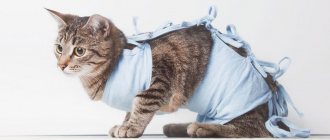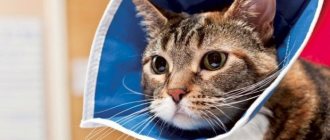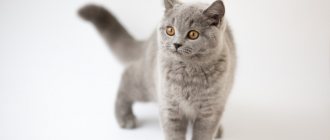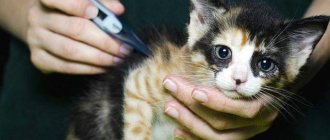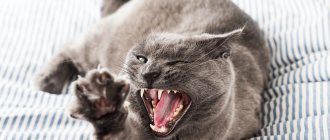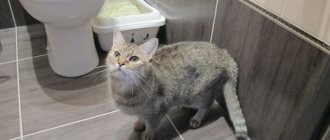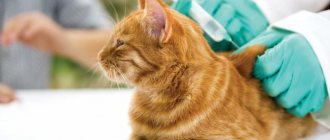Castration of a cat is one of the popular procedures among city residents. Despite its simplicity and accessibility, it still evokes conflicting feelings among owners. Some people consider such an operation necessary to protect their home from unpleasant odors during territory marking, and their pet from unwanted interaction with yard cats. Other owners fear that after castration the cat’s character will deteriorate sharply, and surgical intervention in the reproductive system will cause irreparable harm to the pet’s health. This article will describe the advantages and disadvantages of the operation, and also provide information on how to care for a cat after castration.
Using anesthesia for cats
Caring owners are interested not only in how long it takes for cats to recover from anesthesia after sterilization, but also in the possible danger of the event. Unpleasant consequences can be avoided only if all contraindications are strictly observed.
How harmful is it
The drugs used in animal anesthesiology have a mild and safe effect. All dosages are selected individually based on the analysis of the mustachioed patient. Before surgery, the veterinarian must check the functioning of the heart to assess possible risks.
Please note that there is always a possibility of death. A doctor’s denial of this fact is a lie that leaves an imprint on his competence. The main task of the anesthesiologist and veterinary therapist is to minimize risks. By taking into account contraindications and choosing the right drug and dose, the likelihood of complications is close to zero.
Contraindications
After anesthesia, the cat’s body is greatly weakened, so additional aggravating factors are detrimental to it. Contraindications for surgical intervention include:
- diseases of the respiratory system and heart;
- periods of estrus, gestation and feeding of offspring;
- age more than 10 years;
- pathologies of the genitourinary system in chronic form and viral infections in acute form.
Despite these limitations, they can be neglected. This is acceptable if the animal’s life is at risk and other methods of treatment do not help it - then the risk of surgery fades into the background.
Veterinarians do not recommend using anesthesia more than once a year - if time is of the essence, it is better to postpone the operation or use alternative treatment methods.
Pain relief after surgery
Usually, after surgery, a cat is given an anesthetic in the form of an injection directly at the veterinary clinic. Some veterinarians are of the opinion that this is not necessary, but the cat is clearly in pain after surgery, and I would like to somehow alleviate her suffering.
Owners of purring cats should remember that under no circumstances should they use human medications that can harm the animal.
It is necessary to consult a veterinarian about how to numb your cat. The doctor will prescribe the necessary medications, tell you how and how often they should be given or injected.
It is advisable that the cat owner have the opportunity, in the event of an unforeseen situation, to contact the doctor and agree with him on a plan of action, discuss the condition of the pet if it raises any concerns or any difficulties are observed.
How to prepare an animal for surgery
Most complications that appear in the postoperative period are associated with a sharp drop in immunity. To preserve the body's defenses, it is important to prevent any pathological conditions that could harm the pet.
Most often, operated patients become infected with worms and viruses, so treatment against parasites and vaccination are prerequisites for operations under general anesthesia. An anthelmintic is given 1.5 weeks before the procedure, and the vaccine is administered no later than a month.
If vaccination is missed according to schedule, then a serum injection is used. It gives similar results in a shorter time - within 2 weeks.
A couple of days before the operation, the blood and urine of the future patient are checked for possible deviations. To calculate the volume of anesthesia, indicators obtained on ultrasound and x-ray of the respiratory and cardiac organs are taken into account.
Half a day before the start of the operation, the cat should not be fed, and 3 hours before the operation, the cat should not be given water. The absence of solid and liquid food prevents the occurrence of nausea, which can lead to pneumonia due to aspiration of vomit.
Rehabilitation period
Caring for a cat after sterilization continues after it recovers from anesthesia. In a day you need:
- start treating stitches with antiseptics daily (once every 24 hours);
- control the holding of a special blanket or collar;
- Sprinkle bleeding sutures with bactericidal agents.
The fluffy beauty recovers completely from the operation, most often on the fourth or fifth day after surgery. During this period, the cat returns to activity. She begins to get out of the lounger, jump, and run. On the street he can easily climb a tree.
Due to such violent activity, the seams come apart, so you should try to limit your pet’s movements. Postoperative wounds usually heal within ten days . If the sutures were protected with absorbable threads, they are not removed. Otherwise, you need to contact a veterinary clinic. Sutures should only be removed by a doctor so as not to harm the animal.
How cats go under anesthesia
In addition to assessing the external condition, the anesthesiologist takes into account the stress level of the mustachioed patient. It is permissible to use premedication - a preparatory procedure that includes the administration of sedatives.
Speed of "falling asleep"
Intramuscular or subcutaneous premedication is carried out 10-15 minutes before the anesthetic is administered. In most cases, animals are “euthanized” with Propofol. The speed of falling asleep varies from person to person, but on average it takes 10-30 minutes.
It is important to understand that the anesthetic is necessary only so that the mustachioed patient does not interfere with the surgeon’s work. It does not eliminate pain. Analgesics, which are calculated separately, cope with this task.
State of immobility
Immobility is achieved not only thanks to the anesthetic, but also with the help of muscle relaxants, which relax the muscles. To assess the condition of the body, the mustachioed patient is connected to special sensors. Modern equipment independently monitors any deviations. In emergency cases, it starts the artificial ventilation system to avoid suffocation when pulmonary activity is low.
The cat is in a completely immobilized state for 1-3 hours. This time is enough to carry out most operations.
What does a seam look like after sterilization?
Most often, the seam looks like a small (1-3 cm) smooth, clean scar, from which 2-3 threads stick out. Nowadays, more and more often, an intradermal cosmetic suture is made, from which no threads stick out, or the operation is performed laparoscopically - in this case, there is no suture left. In the first days after the operation, the suture may slightly (just a little!) tint, and sometimes swell quite a lot. Usually no intervention is required other than maintaining cleanliness and protection from licking. A thick lump can be felt under the skin, resembling a loaf of bread to the touch. This is normal and the swelling will completely disappear in a few weeks.
How long does it take for a cat to recover from anesthesia?
Having figured out the speed of “falling asleep”, it remains to find out how long it takes the cat to recover from anesthesia. The duration of awakening is influenced by the physiological characteristics of the individual patient and the type of drug chosen.
Influence of physiological factors
Ordinary yard cats and male cats recover from anesthesia faster than purebred cats. Artificially bred animals often have cellular mutations that weaken the immune system. The hardest time is for the British, Siamese, Himalayans, Bengals and Sphynxes.
In addition to breed, age and general health are important. A kitten without pathologies will tolerate the procedure easier than an adult pet with chronic diseases.
On average, wake-up time is 2-8 hours. Restoring for an entire day is acceptable, but is an exception.
Dependence on an anesthetic drug
The amount of incoming anesthetic is reduced 10 minutes before the end of the procedure. The safest type of anesthesia is gas. It does not settle in the internal organs and completely leaves the body through the lungs during breathing. This drug is recommended for animals with kidney and liver pathologies. It costs more than its injection counterparts, but is superior to them in terms of weathering speed and safety.
In addition to the type, the quantity of the drug is also important. The lowest dosage is used for castration and dental treatment.
Changes in your pet's behavior
After surgery to remove the testes, uncharacteristic behavior can persist for up to 5 days. These few days your furry friend may experience the following symptoms:
- impaired coordination of movements;
- inhibited reaction;
- unsteadiness of step;
- poor appetite;
- involuntary emptying.
We recommend this article:
When and at what age should a British cat be neutered?
Poor appetite
Impaired coordination of movements
Unsteadiness of step
Active cats often try to climb onto window sills, shelves or cabinets, and therefore during the recovery period it is better to limit their access to high places to avoid falls and injuries.
Even after the most gentle anesthesia, thermoregulation may be impaired in animals. To make your pet more comfortable, it is advisable to build him a kind of nest from warm fabric. In this case, heating pads or other heating devices are strictly contraindicated, as they can lead to serious burns.
Sometimes, when recovering from anesthesia, cats vomit with pronounced foam, mucus and bile. Less commonly, accompanying symptoms include involuntary muscle contractions or excessive, uncontrollable salivation. There is no need to be afraid - this is a normal reaction of the body, which tries to remove toxins as quickly as possible.
We recommend this article:
At what age should Scottish cats be spayed and neutered?
The first signs of awakening
The first hours after anesthesia, the cat remains in the hospital. At this time, doctors monitor their cardiac activity to exclude complications and promptly provide first aid if necessary.
The pet is handed over to the owner only after complete awakening. In the first day you will have to constantly look after him, since, in addition to drowsiness, there is a lack of coordination.
Animal behavior
After returning to normal conditions, the animal will try to get up to walk around the room. Moving paws will shake confidence in safety. A frightened cat may become aggressive. You should not try to help her if the actions taken do not threaten her safety.
Over time, aggressive behavior gives way to apathy. The animal crashes into the walls, falls out of the blue and has difficulty holding its head up. In this state, he really needs the moral support of his owner. Talk to him in a soft voice and stroke him to relieve any fear and tension that has arisen.
What to watch out for
During abdominal operations, a special blanket is put on the animal. This prevents him from licking the wound and protects him from the seams coming apart. Sometimes a special cone collar serves this purpose.
The anesthetic lowers body temperature and prevents free blinking. At first, the cat will be cold and will not be able to close its eyes. Every half hour she will have to instill eye drops to protect her mucous membranes from drying out.
Set up a comfortable and warm place on the floor, covering it with a disposable diaper - the animal may wet itself. Make sure your pet doesn't jump. Due to poor coordination, she may fall and get hurt. In case of severe weakness, it is better to place your pet on the right side. This will make the heart work easier.
When protecting your cat from the cold, do not go to extremes. Using a heating pad and heating devices is fraught with the development of an inflammatory process. If your pet is trembling, cover it with a blanket. Try to keep children and other pets away from it. In a calm environment, the cat's behavior will be more appropriate.
In case of prolonged apathy and lack of physical activity, check the reaction to stimuli:
- Open your pet's eyelids. When exposed to sunlight or artificial light, the pupils should contract.
- Blow gently into your ear. Feeling the flow of air, the pet should move its ear.
- Make a clap over the animal's head. It should flinch in surprise.
If the reaction is positive, then just be patient. You should consult a doctor only if your pet does not respond to any of the stimuli.
Duration of anesthesia
The amount of time a cat spends “sleeping” largely depends on the type of substance administered, as well as the method of application. Simple surgical procedures, such as castration or dental surgery, are performed using short-term medications. After such anesthesia, the cat comes to its senses faster. Sometimes awakening happens while still in the clinic or on the way home.
Longer-acting drugs are used for complex operations. Anesthesia in this case lasts from two to 8 hours. The speed of recovery from “sleep” largely depends on the individual characteristics of the body.
After the operation, you need to ask your veterinarian how long the normal recovery from anesthesia lasts in a particular case.
Aftercare
The likelihood of injury or other complications under constant supervision is reduced to almost zero. For the safety of your mustachioed pet, take a few days off or vacation during the postoperative period.
Drink
Drinking on your own is prohibited for the first 3-4 hours. Due to a violation of the swallowing reflex and severe drowsiness, the pet runs the risk of choking while swallowing or involuntarily falling asleep right in the bowl.
Wait until the stiffness disappears and the animal can hold its head up on its own. Until this time, feed him in small portions through a pipette or syringe without a needle. This will protect against dehydration and drying out of the mucous membranes.
Feeding
If fluid loss is unacceptable, then fasting on the first day is quite acceptable. Wait until the animal has completely recovered from the anesthetic and shows interest in food.
With the return of coordination, offer your pet liquid dishes (broths, watery cereals). Such light meals are digested faster, helping to avoid constipation. You will have to temporarily stop dry feeding. If your pet is not used to regular food, then use pouches and canned soft food.
The temperature of the food should be at room temperature. It is useful and safe for the gastric mucosa. The frequency of feedings will have to be increased and portions reduced. You need to return to your usual regimen and volumes very smoothly to avoid stress on the gastrointestinal tract.
Seam processing
On average, it takes 7-10 days for wounds to heal. Until this time, you will have to protect them from damage, getting wet and suppuration. The seams must be dry and clean, so additional processing is best avoided. The use of ointments and other drugs in liquid form inhibits regeneration and is only permissible as prescribed by a veterinarian.
How does a cat go to the toilet?
Due to the loss of control over defecation and urination in the first hours and even days, the pet may walk under itself. Be sure to put moisture-resistant diapers in the bed and change them immediately after bowel movements.
During the entire rehabilitation period, there should be a tray next to the bed. With poor coordination, it is very difficult to relieve oneself accurately, so searching for a toilet will only make the situation worse. Temporary difficulties will disappear when sensitivity returns to the hind legs.
When can you go for a walk?
Quarantine will have to be observed for at least 14 days. There are many dangers on the street: ticks, viruses, bacteria, helminths, fleas. Infestation with parasites or infection can lead to inflammation of the wound and deterioration of the general condition.
The risk of infection at home is lower, but still remains. For prevention, the animal is sometimes given 2 injections of antibiotics. The first is done at the end of the procedure, and the last - two days later.
How does the cat feel?
Some owners worry that the cat will feel pain during surgery. It's a delusion. A number of drugs are used for anesthesia, which are aimed not only at “euthanizing”, but also at weakening the muscle tone of the animal. It happens that a cat can come out of anesthesia earlier than expected, sometimes on the operating table. Even in this case, the animal will not feel anything, thanks to drugs that “turn off” sensitivity.
Feeding a castrated cat natural food
So, successful castration of the cat is behind us, care after the operation is the next step for the animal’s quick recovery. If your furry friend is accustomed to natural food, you should not suddenly change your taste preferences. Continue to pamper your pet with the usual foods, only in smaller quantities and with some restrictions.
Useful natural for neutered pets:
- Fermented milk products with a small percentage of fat content.
- Boiled and raw vegetables (approximately 15% of the total diet). You can combine these products with meat dishes.
- Raw lean meat, previously frozen. This product can also be served lightly boiled.
- Raw quail eggs.
- Liver, kidney, hearts and other offal (boiled or raw, without spices and salt).
- Small portions of porridge made from buckwheat, rice and oatmeal.
- Chicken bouillon.
- Sometimes you can give fruit in small quantities.
Make sure your cat always has clean water in his bowl to drink. Rinse the bowl regularly to remove food debris. Do not overfeed and do not be lazy to cook separately for your four-legged friend. Proper care after sterilization is the key to a long and happy life for your furry family member!
More information about sterilization can be found here
The most popular and recommended cat food brands
Sterilization radically changes the life of a pet and its habits. If earlier your cat urgently demanded a walk and was looking for a cat, now he is only interested in food. A cat that eats excessively high-calorie foods will begin to gain weight, and this is already a bad sign for the animal. To keep his figure normal, choose the right food!
The range of cat products includes two main types of food: dry and wet. They differ in composition and cost. If the owner chooses the first option, it is necessary to provide the animal with constant access to drinking water.
Which food is better, dry or wet, is up to you to decide; there is no clear answer to this question. The main thing is to choose a fresh composition of proven quality with mandatory certification, giving preference to reliable brands. Experts do not recommend choosing budget food. Such savings can negatively affect the health of the animal.
Premium class food
Experienced breeders recommend giving preference to the following brands:
- Hills – a large assortment of therapeutic and prophylactic products that help prevent obesity in animals;
- Royal Canin - nutritional composition rich in vitamins;
- Purina PRO PLAN is a balanced food with pribiotics that improve intestinal function.
Caring for a cat after castration
A neutered cat should be cared for carefully so that rehabilitation takes place in a short time and there are no complications.
How do cats behave when they are in severe pain? They may meow pitifully or lie silently . At the same time, they refuse food and water.
You can tell if a cat is in pain by looking at the dilated pupils and looking at one point. It is the owner's responsibility to help the animal.
Anesthesia affects various systems of the cat's body, including the muscular system . During rehabilitation, the cat may move unsteadily and walk with a staggering gait.
You need to watch where the animal is going , whether it is climbing on objects located at a height. Such recommendations will be important after other operations.
ATTENTION! At first, the cat experiences severe pain. Even if he tolerates them silently, he needs to alleviate the condition with the help of antispasmodics.
How and how long a wound heals depends largely on home care. You should not only properly treat the seam, wash your eyes, and feed him. The cat will need silence and isolation during such a difficult period; you need to behave carefully with him . You should not allow other animals or small children, who may accidentally touch the wound, to be near your pet.
Memo to the cat owner for 7 days
Owners whose cats have undergone castration should follow simple rules for the next 7-10 days. Which will allow you to undergo rehabilitation without problems.
Limit your time outside
Even if the cat feels good after castration, runs around the apartment and plays actively, you should not let him outside. Climbing trees and running into other cats can cause infection. In addition, it is necessary to protect your pet from intense stress. Yes, a cat can be capricious and ask to go for a walk, but you can’t follow the lead. It is important to explain the rehabilitation rules to all household members so that actions are coordinated and the animal remains safe.
Don't wash your cat right away
For a week after castration, refrain from bathing the animal, even if the cat has wet itself. Until the tissues are completely healed, water can become a conduit for infection and cause an abscess. Be patient. As soon as the stitches are removed and the wound at the incision site has healed well (to say the least), you can wash the cat with peace of mind.
What to watch out for
The problem of urolithiasis comes first. Normally, a cat leaves territorial marks, and urine does not stagnate in the bladder. Now the cat will defecate much less frequently, which means the salts have time to form crystals and form deposits in the cavities and ducts of the urinary system.
The first thing the owner should do is to remove from the pet’s diet foods that contribute to the formation of stones (fish, dairy products), and under no circumstances give them spicy, salty, or fatty foods.
The second is affordable drinking. Cats are not big drinkers, but a lack of access to water will greatly aggravate the situation. Clean the litter box often. Animals may refuse to relieve themselves again if the litter box is not cleaned. The cat begins to tolerate it, the urine stagnates, crystallization and inflammatory processes occur.
What to feed the cat, transition to a new diet?
After castration, a cat's metabolic rate will change. The purr will become calmer and the need for large amounts of calories will disappear. The diet should be reduced. Make it nutritious, as free as possible from ballast, which can turn into fat deposits.
Substances that help remove excess salts from the body are added to specialized feeds. The food is easier to digest and still provides enough energy for play.
Be sure to discuss feeding rules with your veterinarian so that they can help you calculate the daily intake based on the animal’s weight. Make your pet's nutrition complete but safe, based on the recommendations of experts or give preference to a trusted manufacturer.
It will be useful for you to know how to choose the right food for a neutered cat.
How the procedure is performed
Castration is performed under anesthesia by an experienced veterinarian.
necessarily take place in a veterinary clinic , which has specialized equipment and medications.
The cat remains under the supervision of a specialist for a while, who will monitor what is happening to the pet, how its cardiac and respiratory systems work.
For future health, the first time after the procedure and the condition on the first day are important..
ATTENTION! Owners of cats or dogs should always have the phone number of a good veterinarian at hand. Moreover, after the procedure, cat castration is an operation.
Cats are castrated under anesthesia ; animals tolerate its effects in different ways. They may experience unpleasant symptoms such as nausea and dizziness. Sometimes muscle weakness is also noted, the cat moves with difficulty at first and eats poorly.
At first, this is a normal phenomenon; most cats tolerate castration without serious consequences. You should not leave your pet in the clinic for more than a day (if there are no health problems).
It is important for cats to feel at home , to feel the attentive attitude of their beloved owner. This makes the rehabilitation of his body easier.
Anesthesia and eyes
The cat's body is designed in such a way that while under anesthesia, cats' eyes remain open. This does not mean that the animal can see everything around during the operation.
To prevent the mucous membrane of the eye from drying out, the veterinarian will advise you to buy special eye drops. Not vitamin solutions and medications that relieve redness, but ordinary drops that prevent the cornea from drying out. They need to be dripped into the cat during surgery, as well as periodically during recovery from anesthesia.
When instilling, you need to press the upper and lower eyelids, simulating blinking, because the cat's eye itself will not be able to distribute the solution throughout the mucous membrane.
